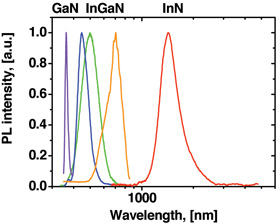
| Home | About Us | Contribute | Bookstore | Advertising | Subscribe for Free NOW! |
| News Archive | Features | Events | Recruitment | Directory |
| FREE subscription |
| Subscribe for free to receive each issue of Semiconductor Today magazine and weekly news brief. |
News
22 October 2008
Oxford Instruments-TDI develops technique for HVPE growth of InGaN
UK-based Oxford Instruments plc says that its subsidiary TDI (acquired in April) has extended hydride vapor phase epitaxy (HVPE) technology to the growth of indium gallium nitride (InGaN).
The InGaN alloy materials typically forming the active region of green-blue-violet light-emitting optoelectronic devices based on III-nitride compounds are normally grown using metalorganic chemical vapor deposition (MOCVD) or molecular beam epitaxy (MBE).
In contrast, HVPE is best known for its capability to grow low-defect, crack-free, high-quality quasi-bulk gallium nitride (GaN) and aluminium nitride (AlN) materials at a high growth rate of up to 100 microns/hour. TDI uses its patented HVPE technology to manufacture nitride materials (including GaN, AlN, AlGaN, InN and InGaN epiwafers), mainly for applications in solid-state lighting (high-brightness LEDs), short-wavelength optoelectronics (laser diodes) and RF power electronics (high-electron-mobility transistors).
But, based on the GaCl3-InCl3-NH3 system of precursor materials, the new HVPE technique developed by Oxford Instruments-TDI can precisely control the growth rate of InGaN down to just 1-2 microns/hour with indium content of up to 43%.
The x-ray diffraction reciprocal space mapping (RSM) technique has been used to study the strain relaxation of the InGaN layers. The studies show that low-indium-content layers (InxGa1-xN with x~0.08-0.15) were either fully strained or partially relaxed, with relaxation strongly depending on the layer thickness and full relaxation for higher-indium-content layers (x~0.2-0.4). The results were presented at July's 2nd International Symposium on Growth of III-Nitrides in Izu, Japan and at the International Workshop on Nitride semiconductors (IWN 2008) in Montreux, Switzerland earlier in October.
 “This study further confirms the ability of HVPE to grow high-quality InGaN layers and extend its capability for blue-green LED production in the near future,” says Dr Alexander Syrkin, deputy director and team leader for the InGaN project at TDI.
“This study further confirms the ability of HVPE to grow high-quality InGaN layers and extend its capability for blue-green LED production in the near future,” says Dr Alexander Syrkin, deputy director and team leader for the InGaN project at TDI.
Graphic: Room-temperature photo-luminescence spectra of HVPE-grown materials: GaN, InN, and InGaN with various compositions.
Recently, the study of InGaN growth by HVPE at Oxford Instruments-TDI was rewarded with substantial funding from a US government agency. “We strongly believe that we are just at the edge of discovering the substantial potential of HVPE technology for the solid-state lighting industry in the near future,” says Oxford Instruments-TDI's general manager Bernard Scanlan.
See related items:
OIPT appoints GM for recently acquired TDI business
Oxford Instruments acquires TDI
TDI puts 20-130 micron thick 3-inch GaN epi into production
Search: Oxford Instruments TDI HVPE InGaN Blue-green LEDs
See: Oxford Instruments Company Profile
Visit: www.oxford-instruments.com